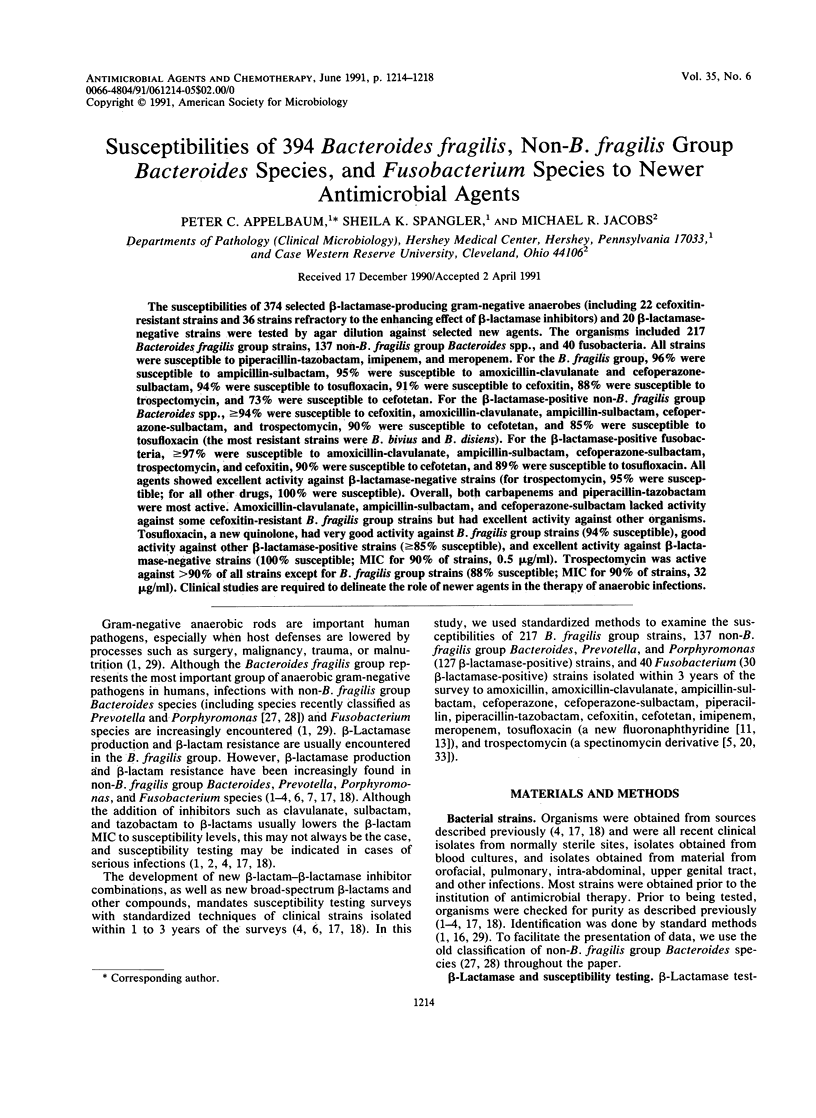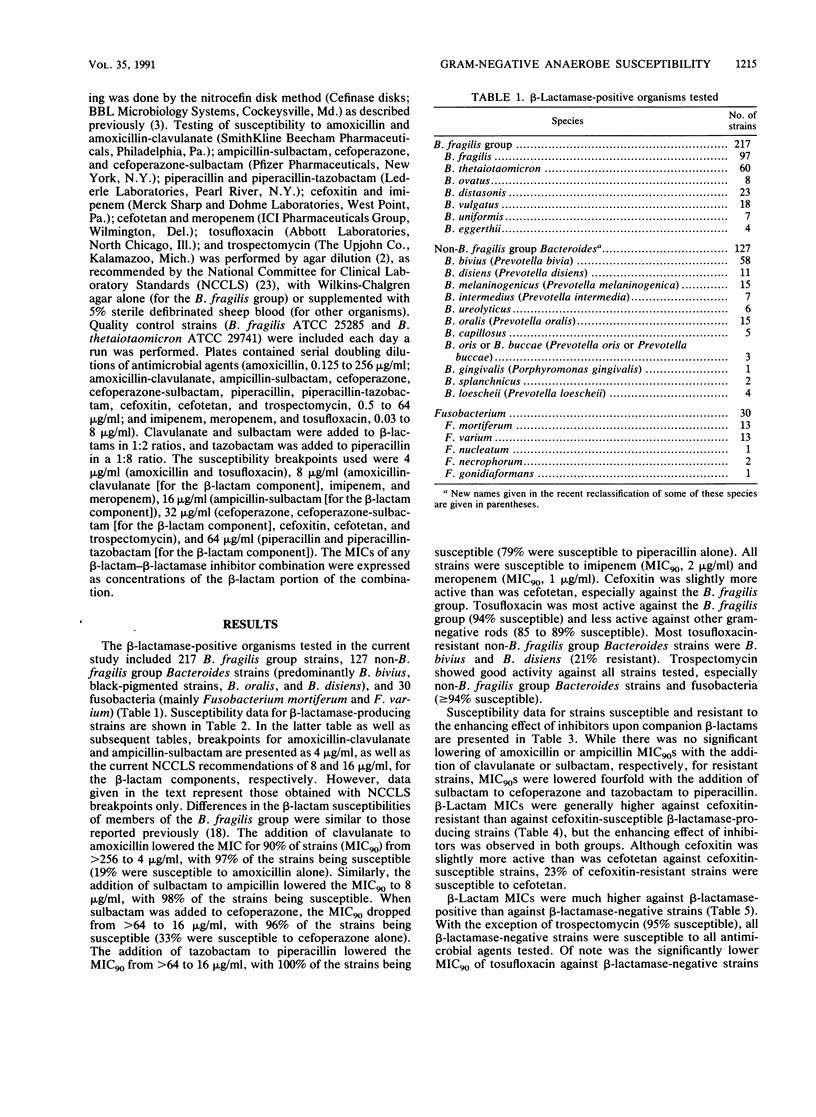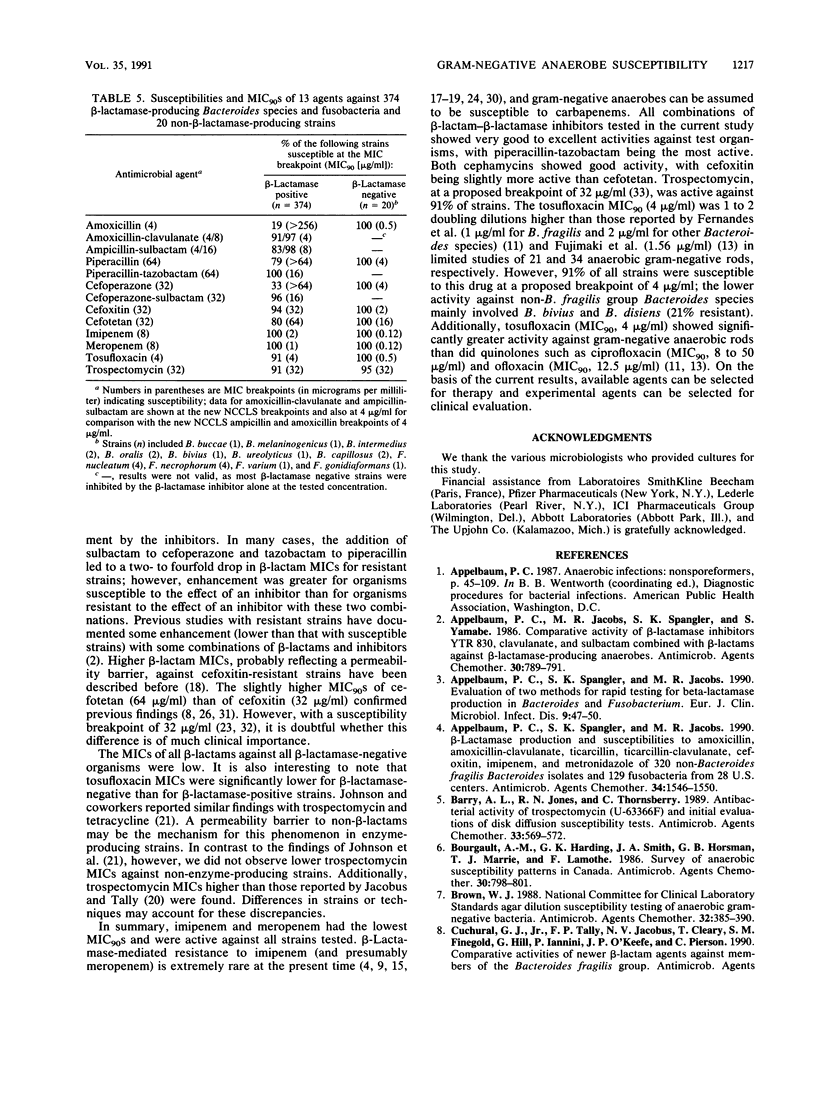Abstract
The susceptibilities of 374 selected beta-lactamase-producing gram-negative anaerobes (including 22 cefoxitin-resistant strains and 36 strains refractory to the enhancing effect of beta-lactamase inhibitors) and 20 beta-lactamase-negative strains were tested by agar dilution against selected new agents. The organisms included 217 Bacteroides fragilis group strains, 137 non-B. fragilis group Bacteroides spp., and 40 fusobacteria. All strains were susceptible to piperacillin-tazobactam, imipenem, and meropenem. For the B. fragilis group, 96% were susceptible to ampicillin-sulbactam, 95% were susceptible to amoxicillin-clavulanate and cefoperazone-sulbactam, 94% were susceptible to tosufloxacin, 91% were susceptible to cefoxitin, 88% were susceptible to trospectomycin, and 73% were susceptible to cefotetan. For the beta-lactamase-positive non-B. fragilis group Bacteroides spp., greater than or equal to 94% were susceptible to cefoxitin, amoxicillin-clavulanate, ampicillin-sulbactam, cefoperazone-sulbactam, and trospectomycin, 90% were susceptible to cefotetan, and 85% were susceptible to tosufloxacin (the most resistant strains were B. bivius and B. disiens). For the beta-lactamase-positive fusobacteria, greater than or equal to 97% were susceptible to amoxicillin-clavulanate, ampicillin-sulbactam, cefoperazone-sulbactam, trospectomycin, and cefoxitin, 90% were susceptible to cefotetan, and 89% were susceptible to tosufloxacin. All agents showed excellent activity against beta-lactamase-negative strains (for trospectomycin, 95% were susceptible; for all other drugs, 100% were susceptible). Overall, both carbapenems and piperacillin-tazobactam were most active. Amoxicillin-clavulanate, ampicillin-sulbactam, and cefoperazone-sulbactam lacked activity against some cefoxitin-resistant B. fragilis group strains but had excellent activity against other organisms. Tosufloxacin, a new quinolone, had very good activity against B. fragilis group strains (94% susceptible), good activity against other beta-lactamase-positive strains (less than or equal 85% susceptible), and excellent activity against beta-lactamase-negative strains (100% susceptible; MIC for 90% of strains, 0.5 microgram/ml). Trospectomycin was active against >90% of all strains except for B. fragilis group strains (88% susceptible; MIC for 90% of strains, 32 microgram/ml). Clinical studies are required to delineate the role of newer agents in the therapy of anaerobic infections.
Full text
PDF




Selected References
These references are in PubMed. This may not be the complete list of references from this article.
- Appelbaum P. C., Jacobs M. R., Spangler S. K., Yamabe S. Comparative activity of beta-lactamase inhibitors YTR 830, clavulanate, and sulbactam combined with beta-lactams against beta-lactamase-producing anaerobes. Antimicrob Agents Chemother. 1986 Nov;30(5):789–791. doi: 10.1128/aac.30.5.789. [DOI] [PMC free article] [PubMed] [Google Scholar]
- Appelbaum P. C., Spangler S. K., Jacobs M. R. Beta-lactamase production and susceptibilities to amoxicillin, amoxicillin-clavulanate, ticarcillin, ticarcillin-clavulanate, cefoxitin, imipenem, and metronidazole of 320 non-Bacteroides fragilis Bacteroides isolates and 129 fusobacteria from 28 U.S. centers. Antimicrob Agents Chemother. 1990 Aug;34(8):1546–1550. doi: 10.1128/aac.34.8.1546. [DOI] [PMC free article] [PubMed] [Google Scholar]
- Appelbaum P. C., Spangler S. K., Jacobs M. R. Evaluation of two methods for rapid testing for beta-lactamase production in Bacteroides and Fusobacterium. Eur J Clin Microbiol Infect Dis. 1990 Jan;9(1):47–50. doi: 10.1007/BF01969535. [DOI] [PubMed] [Google Scholar]
- Barry A. L., Jones R. N., Thornsberry C. Antibacterial activity of trospectomycin (U-63366F) and initial evaluations of disk diffusion susceptibility tests. Antimicrob Agents Chemother. 1989 Apr;33(4):569–572. doi: 10.1128/aac.33.4.569. [DOI] [PMC free article] [PubMed] [Google Scholar]
- Bourgault A. M., Harding G. K., Smith J. A., Horsman G. B., Marrie T. J., Lamothe F. Survey of anaerobic susceptibility patterns in Canada. Antimicrob Agents Chemother. 1986 Nov;30(5):798–801. doi: 10.1128/aac.30.5.798. [DOI] [PMC free article] [PubMed] [Google Scholar]
- Brown W. J. National Committee for Clinical Laboratory Standards agar dilution susceptibility testing of anaerobic gram-negative bacteria. Antimicrob Agents Chemother. 1988 Mar;32(3):385–390. doi: 10.1128/aac.32.3.385. [DOI] [PMC free article] [PubMed] [Google Scholar]
- Del Bene V. E., Carek P. J., Twitty J. A., Burkey L. J. In vitro activity of cefbuperazone compared with that of other new beta-lactam agents against anaerobic gram-negative bacilli and contribution of beta-lactamase to resistance. Antimicrob Agents Chemother. 1985 May;27(5):817–820. doi: 10.1128/aac.27.5.817. [DOI] [PMC free article] [PubMed] [Google Scholar]
- Fernandes P. B., Chu D. T., Swanson R. N., Ramer N. R., Hanson C. W., Bower R. R., Stamm J. M., Hardy D. J. A-61827 (A-60969), a new fluoronaphthyridine with activity against both aerobic and anaerobic bacteria. Antimicrob Agents Chemother. 1988 Jan;32(1):27–32. doi: 10.1128/aac.32.1.27. [DOI] [PMC free article] [PubMed] [Google Scholar]
- Fuchs P. C., Barry A. L., Jones R. N. Evaluation of in vitro methods for testing susceptibility of anaerobes to ampicillin-sulbactam and amoxicillin-clavulanic acid. J Clin Microbiol. 1988 Jun;26(6):1246–1247. doi: 10.1128/jcm.26.6.1246-1247.1988. [DOI] [PMC free article] [PubMed] [Google Scholar]
- Fujimaki K., Noumi T., Saikawa I., Inoue M., Mitsuhashi S. In vitro and in vivo antibacterial activities of T-3262, a new fluoroquinolone. Antimicrob Agents Chemother. 1988 Jun;32(6):827–833. doi: 10.1128/aac.32.6.827. [DOI] [PMC free article] [PubMed] [Google Scholar]
- Goldstein E. J., Citron D. M. Comparative in vitro activities of amoxicillin-clavulanic acid and imipenem against anaerobic bacteria isolated from community hospitals. Antimicrob Agents Chemother. 1986 Jan;29(1):158–160. doi: 10.1128/aac.29.1.158. [DOI] [PMC free article] [PubMed] [Google Scholar]
- Hill G. B., Ayers O. M. Antimicrobial susceptibilities of anaerobic bacteria isolated from female genital tract infections. Antimicrob Agents Chemother. 1985 Mar;27(3):324–331. doi: 10.1128/aac.27.3.324. [DOI] [PMC free article] [PubMed] [Google Scholar]
- Jacobs M. R., Spangler S. K., Appelbaum P. C. Beta-lactamase production, beta-lactam sensitivity and resistance to synergy with clavulanate of 737 Bacteroides fragilis group organisms from thirty-three US centres. J Antimicrob Chemother. 1990 Sep;26(3):361–370. doi: 10.1093/jac/26.3.361. [DOI] [PubMed] [Google Scholar]
- Jacobs M. R., Spangler S. K., Appelbaum P. C. Susceptibility of Bacteroides non-fragilis and fusobacteria to amoxicillin, amoxicillin/clavulanate, ticarcillin, ticarcillin/clavulanate, cefoxitin, imipenem and metronidazole. Eur J Clin Microbiol Infect Dis. 1990 Jun;9(6):417–421. doi: 10.1007/BF01979473. [DOI] [PubMed] [Google Scholar]
- Jacobus N. V., Cuchural G. J., Jr, Tally F. P. In-vitro susceptibility of the Bacteroides fragilis group and the inoculum effect of newer beta-lactam antibiotics on this group of organisms. J Antimicrob Chemother. 1989 Nov;24(5):675–682. doi: 10.1093/jac/24.5.675. [DOI] [PubMed] [Google Scholar]
- Jacobus N. V., Tally F. P. Activity of trospectomycin against Bacteroides fragilis and other Bacteroides species. Antimicrob Agents Chemother. 1988 Apr;32(4):584–586. doi: 10.1128/aac.32.4.584. [DOI] [PMC free article] [PubMed] [Google Scholar]
- Johnson C. C., Wendeler M., Levison M. E. In vitro susceptibilities of oral pigmented Bacteroides species to trospectomycin and other selected antimicrobial agents. Antimicrob Agents Chemother. 1990 Aug;34(8):1597–1599. doi: 10.1128/aac.34.8.1597. [DOI] [PMC free article] [PubMed] [Google Scholar]
- Kuck N. A., Jacobus N. V., Petersen P. J., Weiss W. J., Testa R. T. Comparative in vitro and in vivo activities of piperacillin combined with the beta-lactamase inhibitors tazobactam, clavulanic acid, and sulbactam. Antimicrob Agents Chemother. 1989 Nov;33(11):1964–1969. doi: 10.1128/aac.33.11.1964. [DOI] [PMC free article] [PubMed] [Google Scholar]
- Nord C. E., Lindmark A., Persson I. Susceptibility of anaerobic bacteria to meropenem. J Antimicrob Chemother. 1989 Sep;24 (Suppl A):113–117. doi: 10.1093/jac/24.suppl_a.113. [DOI] [PubMed] [Google Scholar]
- Ohm-Smith M. J., Sweet R. L. In vitro activity of cefmetazole, cefotetan, amoxicillin-clavulanic acid, and other antimicrobial agents against anaerobic bacteria from endometrial cultures of women with pelvic infections. Antimicrob Agents Chemother. 1987 Sep;31(9):1434–1437. doi: 10.1128/aac.31.9.1434. [DOI] [PMC free article] [PubMed] [Google Scholar]
- Ruckdeschel G. Activity in vitro of cefotetan against non-sporing anaerobes: a comparative study. J Antimicrob Chemother. 1983 Jan;11 (Suppl):117–124. doi: 10.1093/jac/11.suppl_a.117. [DOI] [PubMed] [Google Scholar]
- Shah H. N., Collins D. M. Prevotella, a new genus to include Bacteroides melaninogenicus and related species formerly classified in the genus Bacteroides. Int J Syst Bacteriol. 1990 Apr;40(2):205–208. doi: 10.1099/00207713-40-2-205. [DOI] [PubMed] [Google Scholar]
- Souza Dias M. B., Jacobus N. V., Tally F. P. In-vitro activity of cefoperazone-sulbactam against Bacteroides species. J Antimicrob Chemother. 1986 Oct;18(4):467–471. doi: 10.1093/jac/18.4.467. [DOI] [PubMed] [Google Scholar]
- Watt B., Naden M. The growth-inhibitory properties of meropenem against anaerobes of clinical importance. J Antimicrob Chemother. 1989 Sep;24 (Suppl A):119–124. doi: 10.1093/jac/24.suppl_a.119. [DOI] [PubMed] [Google Scholar]
- Werner H. Inhibitory activity of cefotetan and other beta-lactams against anaerobes. J Antimicrob Chemother. 1983 Jan;11 (Suppl):107–115. doi: 10.1093/jac/11.suppl_a.107. [DOI] [PubMed] [Google Scholar]
- Zabransky R. J., Bobey D. G., Barry A. L., Allen S. D., Fuchs P. C., Gerlach E. H., Thornsberry C., Sheikh W., Jones R. N. Quality control guidelines for testing cefotetan in the reference agar dilution procedure for susceptibility testing of anaerobic bacteria. J Clin Microbiol. 1989 Jan;27(1):190–191. doi: 10.1128/jcm.27.1.190-191.1989. [DOI] [PMC free article] [PubMed] [Google Scholar]
- Zurenko G. E., Yagi B. H., Vavra J. J., Wentworth B. B. In vitro antibacterial activity of trospectomycin (U-63366F), a novel spectinomycin analog. Antimicrob Agents Chemother. 1988 Feb;32(2):216–223. doi: 10.1128/aac.32.2.216. [DOI] [PMC free article] [PubMed] [Google Scholar]


